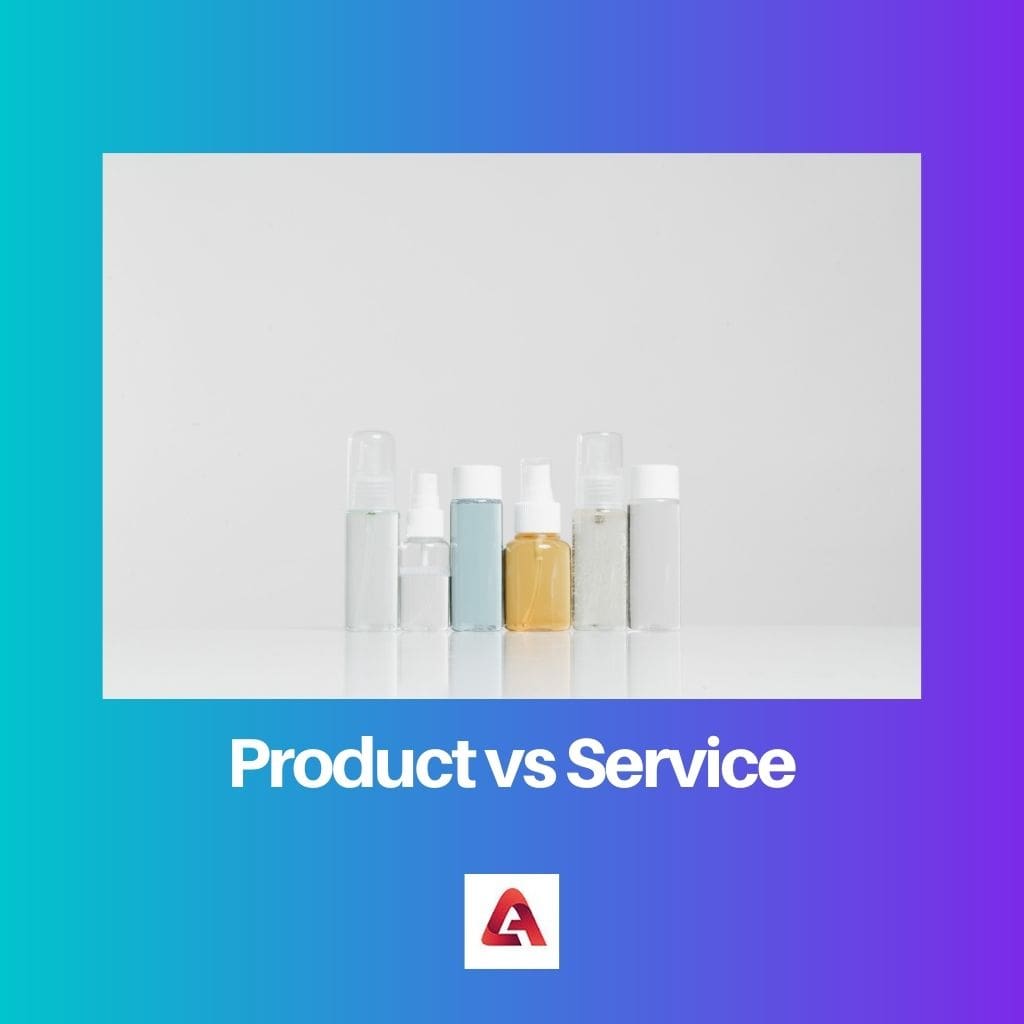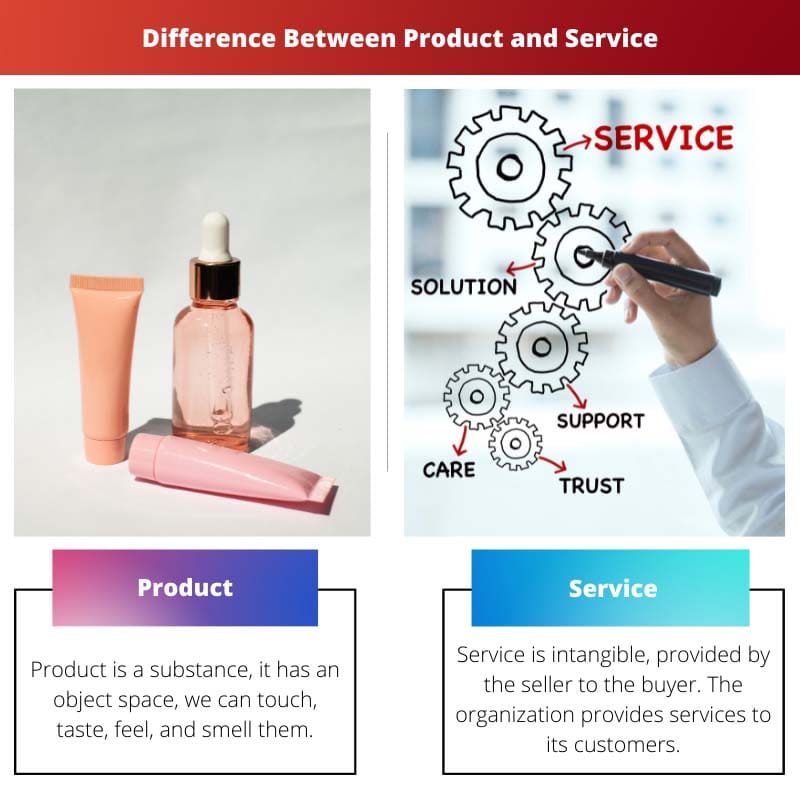Products are tangible items with physical attributes that customers can purchase and own. Services, on the other hand, are intangible offerings characterized by actions, expertise, or experiences provided to customers. While products provide a concrete and lasting value through ownership, services deliver value through actions, knowledge, or temporary experiences.
Key Takeaways
- Tangibility: Products are physical items, whereas services are intangible activities or experiences.
- Ownership: Products result in ownership transfer, while services don’t have ownership transfer.
- Production and consumption: Products are produced before consumption, whereas services are produced and consumed simultaneously.
Product vs Service
The difference between Product and service is that product is an item produced by a company to market and exchanged for money. And Service is provided by the business to the customer on demand.

A product is a tangible item that the organization produces to market and sells to a customer in exchange for money. The product has a physical presence, touch, smell, and taste. The products can be one-time use or used repeatedly.
Services are intangible; it is the service given by a person to another person on demand. People get attracted by the services they get from the organization.
Quality of service is one of the best strategies and approaches to attract customers.
Comparison Table
| Feature | Product | Service |
|---|---|---|
| Tangibility | Tangible – Can be physically touched or held | Intangible – Cannot be physically touched or held |
| Ownership | Customer owns the product after purchase | Customer does not own the service, but pays for its use |
| Production & Consumption | Produced before consumption | Production and consumption happen simultaneously |
| Inventory | Can be stored for future use | Perishable – Cannot be stored for later |
| Standardization | Can have many variations and models | More standardized with less variation |
| Quality Comparison | Easier to compare quality due to tangible nature | More subjective and difficult to compare quality |
| Delivery | Can be delivered physically or digitally | Delivered through the provider’s actions or expertise |
| Examples | Smartphone, clothing, furniture | Haircut, consulting, education |
What is Product?
A product refers to any tangible or intangible offering that satisfies a need or want and can be exchanged for value. Products can range from physical goods, such as electronics and clothing, to services, software, and even ideas. Understanding the various aspects of a product is crucial for businesses and consumers alike.
Types of Products
1. Goods
Goods are tangible, physical products that consumers can touch, feel, and own. Examples include smartphones, cars, and clothing.
2. Services
Services are intangible offerings that provide value through actions or performance. Examples include consulting, healthcare, and education.
3. Hybrid Products
Some products combine both goods and services. For instance, a smartphone not only includes a physical device but also various software services.
Product Life Cycle
1. Introduction
The product is launched into the market. Sales are typically low, and marketing efforts focus on creating awareness.
2. Growth
Sales start to increase, and the product gains acceptance. Profits rise, and competition may intensify.
3. Maturity
The product reaches its peak in terms of sales and market share. Competition is fierce, and companies may focus on differentiation or cost leadership.
4. Decline
Sales decline, and the product becomes less popular. Companies may decide to discontinue or revamp the product.
Key Components of a Product
1. Core Product
The fundamental benefit or solution that the product provides. For a smartphone, the core product is communication and access to information.
2. Actual Product
The tangible features and attributes of the product, such as design, features, and brand.
3. Augmented Product
Additional elements beyond the core and actual product, such as warranties, customer support, and packaging.
Product Development Process
1. Idea Generation
Generating and screening ideas for new products.
2. Idea Evaluation
Assessing the feasibility and potential success of the product ideas.
3. Development
Creating prototypes and developing the product.
4. Testing
Conducting market tests and getting feedback from potential customers.
5. Launch
Introducing the product to the market.
6. Commercialization
Implementing a full-scale marketing and sales strategy.
Branding and Positioning
1. Branding
Creating a distinct identity for the product through a name, logo, and overall image.
2. Positioning
Determining the product’s place in the market relative to competitors.
Marketing Strategies
1. Product Differentiation
Highlighting unique features that distinguish the product from competitors.
2. Pricing Strategies
Setting the right price to maximize profit and market share.
3. Distribution Channels
Determining the most effective ways to make the product available to consumers.
4. Promotion
Creating awareness and interest through advertising, public relations, and other promotional activities.

What is Service?
Defining Service
In the realm of business and commerce, a service is a broad term that encompasses a wide array of intangible offerings provided by one party to another. Unlike tangible goods, services are characterized by their non-physical nature and the experience they deliver. This comprehensive exploration will delve into various aspects of services, shedding light on their definitions, characteristics, classifications, and significance in the modern economy.
Conceptual Understanding
A service can be defined as an intangible act or performance that one party offers to another, often involving a specific skill, knowledge, or expertise. It is an economic activity that is not associated with the production of a physical product but rather focuses on meeting the needs and desires of the consumer.
Key Characteristics
Services exhibit several distinctive characteristics, including intangibility, inseparability, variability, and perishability. The intangible nature of services means they cannot be touched or held, making their evaluation and marketing challenging. Inseparability refers to the simultaneous production and consumption of services, while variability highlights the potential for inconsistency in service delivery. Perishability indicates that services cannot be stored for future use, emphasizing the real-time nature of many service interactions.
Classification of Services
Service Industries
Services can be classified into various industries, such as the service sector, which encompasses activities like financial services, healthcare, education, and hospitality. Understanding the diverse categories of services is crucial for analyzing economic trends and formulating effective business strategies.
Consumer vs. Business Services
Further classification distinguishes between consumer services and business services. Consumer services target individual consumers, offering solutions to personal needs, while business services cater to the requirements of enterprises, supporting their operational and strategic goals.
Significance of Services in the Economy
Economic Impact
Services play a pivotal role in modern economies, contributing significantly to GDP and employment. The shift towards a service-oriented economy has become a global trend, reflecting the increasing importance of services in fostering economic growth and development.
Service Innovation
Innovation in services is paramount for staying competitive. The development of new and improved services enhances customer satisfaction, fosters business growth, and drives technological advancements.
Globalization and Services
The globalization of services has expanded opportunities for cross-border collaborations, enabling the exchange of services on a global scale. This interconnectedness has profound implications for international trade and economic interconnectedness.

Main Differences Between Product and Service
- Tangibility:
- Product: Tangible and physical, can be touched and seen.
- Service: Intangible, often involves actions or processes rather than physical objects.
- Ownership:
- Product: Ownership is transferred from the seller to the buyer.
- Service: No ownership of a physical item; customers essentially purchase a benefit or experience.
- Production and Consumption:
- Product: Produced first, then consumed later.
- Service: Produced and consumed simultaneously; production and consumption are often inseparable.
- Customization:
- Product: Limited customization options, especially for mass-produced items.
- Service: Can be highly customizable to meet individual customer needs and preferences.
- Perishability:
- Product: Generally not perishable, can be stored for a longer time.
- Service: Often perishable and cannot be stored; the opportunity to consume is time-sensitive.
- Quality Assessment:
- Product: Quality can be assessed before purchase through inspection or testing.
- Service: Quality is often assessed after consumption, and it may be subjective based on the customer’s experience.
- Inseparability:
- Product: Produced separately from the consumer.
- Service: Produced and consumed simultaneously, involving direct interaction between the service provider and the customer.
- Ownership Transfer:
- Product: Involves the transfer of ownership rights.
- Service: No transfer of ownership; customers pay for the use or experience.
- Return and Refund:
- Product: Generally easier to return or refund if it doesn’t meet expectations.
- Service: Refunds may be more complex, especially if the service has been partially or fully delivered.
- Marketing Approach:
- Product: Emphasis on tangible features, branding, and packaging.
- Service: Focus on intangible benefits, customer experience, and relationship-building.
- Customer Interaction:
- Product: Limited direct interaction with customers during the sale.
- Service: Often involves direct interaction and communication between service providers and customers.




